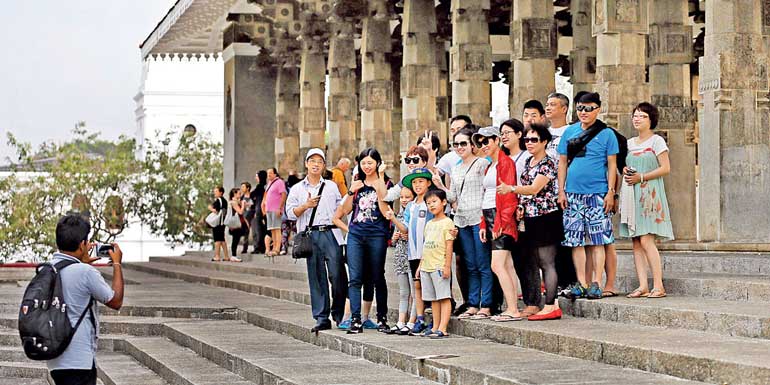Thursday Dec 11, 2025
Thursday Dec 11, 2025
Wednesday, 29 June 2016 00:00 - - {{hitsCtrl.values.hits}}

A group of Chinese tourists enjoying the visit to the Independence Square
Q: How was winter 15/16 for the destination and how do you see summer 16?
A: Sri Lanka recorded a good winter 15/16 with most markets performing exceptionally well. YOY growth in tourist arrivals for the winter season October to March recorded a healthy growth of 19% and the prospects for the summer season looks promising.
 Q: Why is everyone talking about the Chinese Tourist?
Q: Why is everyone talking about the Chinese Tourist?
A: The statistics over the past 10 years indicate China as the biggest outbound market in the world despite approximately only 6% of Chinese holding passports. From 2011 to 2015 the outbound tourism from China increased from 70 million to 120 million.
According to UNWTO countries such as Thailand, Korea and Japan have experienced significant growth from China whilst Europe and North America too has seen rapid growth. Thailand received eight million tourists from China which is more than one third of the countries entire inbound arrivals. Over the last three years China has been the leading producer to Maldives tourism. This clearly shows the importance and the potential in China Outbound tourism.
The outbound tourist shopping by Chinese has surpassed $ 200 billion in 2015 and it is said to double within the next five years according to the Fung Business Intelligence Centre (FBIC). The main driving force for this increase is due to the rise in personal income, variety and choice available overseas and the desire to purchase branded items.
Q: How is the Chinese market doing overall in outbound tourism and into Sri Lanka?
A: The Chinese government is supporting the tourism sector by paying more attention to two key drivers that promote the leisure industry. The paid leave policy and change in the National Holidays. Ctrip, one of the most popular travel review websites in China indicates that 80% of the paid leave is utilised for travel.
China is currently recording the highest growth from all the major markets to Sri Lanka. According to a pre survey conducted by Mafengwo.com, which is a leading travel information platform in China, Sri Lanka was ranked the 9th most wanted travel destination during the Labour Day holiday period in 2016.
Sri Lanka is well positioned when considering the outbound market of China. For the period January to May compared to 2015 we see a 42.7% increase in Chinese Tourist arrivals in 2016, considerably higher than other major markets. Sri Lanka has many unique strengths which attract the Chinese traveller – an island destination, mysterious and unexplored, medium haul, rich diversity, warm and friendly people and the pristine beaches. Sri Lanka’s location on the Silk route is also a key element which will have a positive impact on the ‘the Belt and the Road’ initiative introduced by the Chinese Government.
Another interesting trend is the significant growth in FIT segment with more younger generation Chinese travelling on their own. This is further complimented by the growth in the MICE segment and the luxury high end segment. Sri Lanka is well positioned to record exponential growth from China and it will be our biggest inbound source market.
Q: What are the key differences between a Chinese Tourist and a European Tourist?
A: Chinese prefer a planned itinerary and to travel in a groups whilst the European traveller may not necessarily travel in groups but more individually. A major difference would be the duration of the holiday where the European average stay is usually 10-12 days, whilst the Chinese traveller ranges from 5-7 days. The Chinese tourist prefers a compact busy program with many activities whilst the European tourist does the program at leisure.
The purchasing power of Chinese tourists is strong and they like to spend on shopping, buying authentic local souvenirs, food and local experiences much more than a European tourist. They are the highest buyers of Sri Lankan gems/jewellery and tea. Average Chinese spends about 45% of their travel budget on shopping and 8 out of 10 would say that shopping is a vital part of their tour.
Q: Which tourist is beneficial for a country like Sri Lanka?
A: The total spend by a European traveller is more due to the length of stay in the country. However, if you analyse the average spend, the Chinese traveller’s spend per day is more than a European traveller. As a destination we need both.
Q: If you compare the yield which tourist will benefit a hotel, a travel company and the country and why?
A: On the package price Chinese travellers would be sensitive, but they are willing to spend on food and beverage particularly sea food and other activities such as spa treatment etc. With approximately 45% of the package price available for shopping there spend in the destination is substantial.
Our hotels should gear themselves to upsell accordingly with premium value added products. Likewise the travel companies should offer innovative products and excursions which has appeal. Both European and Chinese tourists have their unique strengths and advantages and as a destination we should be able to evaluate them properly and derive the best.
Q: Are we geared to handle the Chinese Tourist in Sri Lanka? If not which areas do we improve and focus?
A:Our experience in handling Chinese traveller is relatively new. Though we have adapted well, the requirements from these two nationalities differ vastly and we have room for improvement as our mentality and mind set is still more European.
We have to understand the needs and interests of the Chinese traveller and accommodate these accordingly. This would require high quality mandarin speaking guides, Chinese signage in places of interest and hotels, authentic Chinese cuisine and wifi connectivity. As shopping is one of the main interests of the Chinese traveller we need to improve the quality and packaging of our products and price them reasonably in order to make an impression. There should be more experience based activities which are interactive and engaging to stimulate interest.
Q: With a huge influx of Chinese tourists arriving, will it change the total landscape of Sri Lanka tourism? If so, how should we manage the situation?
A: We will go through a significant change but it will not change the total landscape of Sri Lanka’s tourism. One of the serious concerns which is getting escalated is the fact that handling Chinese tourists is happening in an unregulated manner. With the influx in numbers, we see a significant increase in travel agents specialising in handling Chinese travellers and some of them unfortunately do not conform to the guidelines stipulated by the tourism authorities. When the business becomes unregulated it leads to various malpractices which SLAITO and other associations have brought to the notice of the Chairman/Director General of SLTDA and tourist police. We urge the authorities to look into this as it is a serious concern which needs to be addressed immediately. The rules and regulations must be strictly adhered to ensure sustainable growth.
Q: Chinese are the biggest in our neighbouring Maldives, any lesson we can learn from them?
A: Maldives is a destination which was created by European tour operators to cater to the needs of the European traveller.
The biggest learning from Maldives is how quickly and efficiently they changed from a very European centric destination to meet the needs and demands of the Chinese traveller. Being a beach destination managing a 3-4 night average stay for Chinese traveller as opposed to a 12-14 night stay of a European traveller is not easy.
They had a clear and sustainable marketing strategy and the slogan ‘Love me, then take me to Maldives’ in mandarin made a very strong impact in China.
Q: Do you think Sri Lanka tourism has a clear plan to attract Chinese Tourists? What sort of promotional activities should we target in the next 2-3 years in the Chinese Market?
A: Sri Lanka tourism needs to do more and must have a clear sustainable China marketing strategy to brand the destination. It should be short, medium and long term covering the main cities which has direct connectivity and move to cities which have potential such as Shenzhen, Hangzhou, Chongqing, Shenyang, Wuhan, Changsha, etc. Sri Lankan airlines currently operate 21 frequencies a week out of Beijing, Shanghai, Kunming, Guangzhou and Hong Kong. Chinese airlines, Air China and China Eastern operate direct out of Chengdu, Shanghai and Kunming.
In addition there is connectivity on Cathay Pacific and other Asian airlines. Hong Kong Airlines is planning to fly from November and air lift is not a major concern as capacity will increase with the demand. We need to position Sri Lanka as ‘The tropical island destination’ in the minds of the Chinese Traveller.